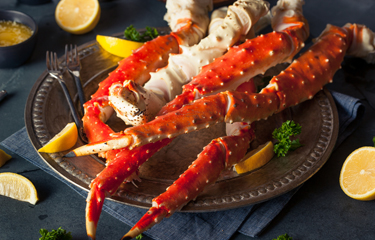Crab sales at U.S. retailers have hit record highs, with the category as a whole up over 60 percent, and king crab has been buoyed by the surge.
Customers at the retail level are buying record numbers of king crab, according to Michael Kotok, the president of Buffalo, New York, U.S.A.-based Arctic Fisheries. Kotok was speaking during the National Fisheries Institute’s Global Seafood Market Conference webinar series; SeafoodSource is providing exclusive coverage of the GSMC webinar series, which will be providing exclusive market-focused content throughout 2021.
Despite the price-spikes – 9-12 count leg and claw crab is selling for as much as USD 28 (EUR 23) per pound – customers are still buying, Kotok said.
“Based on some experiences I’ve had with consumers, even though prices are at record highs, it’s still cheap [for them],” Kotok said.
According to Kotok, the shift from foodservice to retail sales caused by COVID-19 presented a unique opportunity for the sector. King crab prices, Kotok said, aren’t something many customers would be familiar with, because many of the people buying crab have never actually purchased it from a seafood counter in a retail setting.
“People tell me at the seafood counter when they’ve been buying king crab, most of them are ignorant because they’ve never gone to the seafood counter before,” he said.
Local restaurants selling king crab legs will often sell them for much more than the typical retail price, Kotok said.
“The local seafood restaurant, their menu [price] is USD 80 [EUR 66] for two legs,” he said. “I confirmed that those two legs are slightly under two pounds.”
Customers buying the same crab at the retail store will often buy a cheaper size of crab for substantially less than the price they would pay at a restaurant.
“These people told me at the store, ‘It’s cheap for us to buy this here,’” Kotok said. “This shift from foodservice to retail I think has brought a lot of different consumer orientations that we haven’t seen before, and I think it’s going to be a challenge and an opportunity for retail and foodservice both.”
The surge in sales is coinciding with a shift in king crab sourcing. Alaskan king crab supplies have continued to diminish from past peaks, while Russia is ramping up its efforts to develop the resource. Kotok said he doesn’t see the Alaskan fishery bringing more product to market in the near-future.
“You’re going to need to see the biomass recover. It seems that it is a thinner biomass, and it’s moving a lot," he said. "This is simply a matter of numbers."
Meanwhile, Russia is pushing more king crab into the United States.
“With a decline of some of the oil wealth in Russia, they’ve been keen on developing fishing wealth,” he said. “They’re putting much more investment into the Far East [region].”
But Russia has plenty of options for what to do with its crab. By far the biggest market for Russian king crab is the Chinese live market, which is easy to cater for – processing of product is minimal, and the main challenges are logistical, Kotok said.
“In the beginning of the season, the money was where the live crab was, so that’s where product went,” Kotok said. “You did not see a lot of imports, because that product was being produced for Asian live [markets].”
More Russian imports are coming to the U.S., however, and Alaskan product is no longer fetching a premium over Russian product the way it once did.
“As this was a developing fishery for the Russians, and a developing market to the U.S., there was a significant difference [in quality],” Kotok said. Now that Russia has invested into developing the fishery, that premium is relatively minor, he said.
Overall, Kotok predicted king crab prices are unlikely to move away their current heights, as demand hasn't abated and supply remains tight. Global shipping issues, including shipping container shortages, are further squeezing the king crab supply chain. Shipping constraints have “compressed” pricing on all sizes of crab, with smaller sizes fetching prices just under those of larger, more premium sizes, Kotok said.
“I’d hate to use this word, but it’s supply, [and] it’s very limited. Kotok said. “People are going to pay for anything.”
Photo courtesy of Brent Hofacker/Shutterstock







